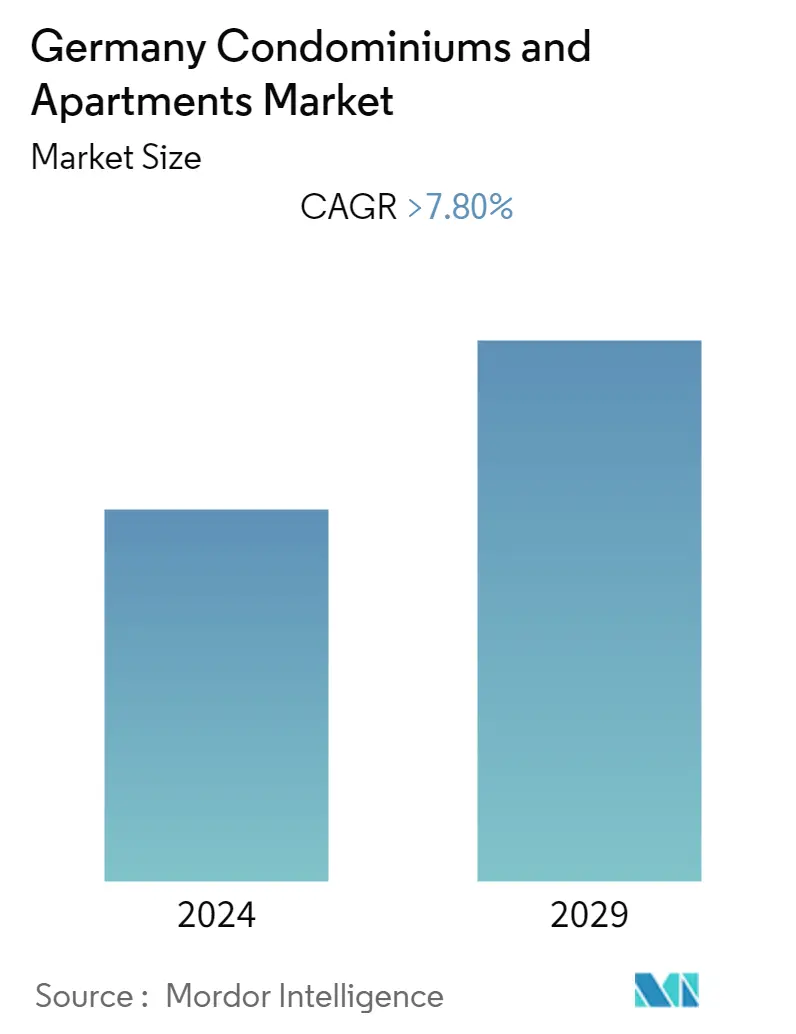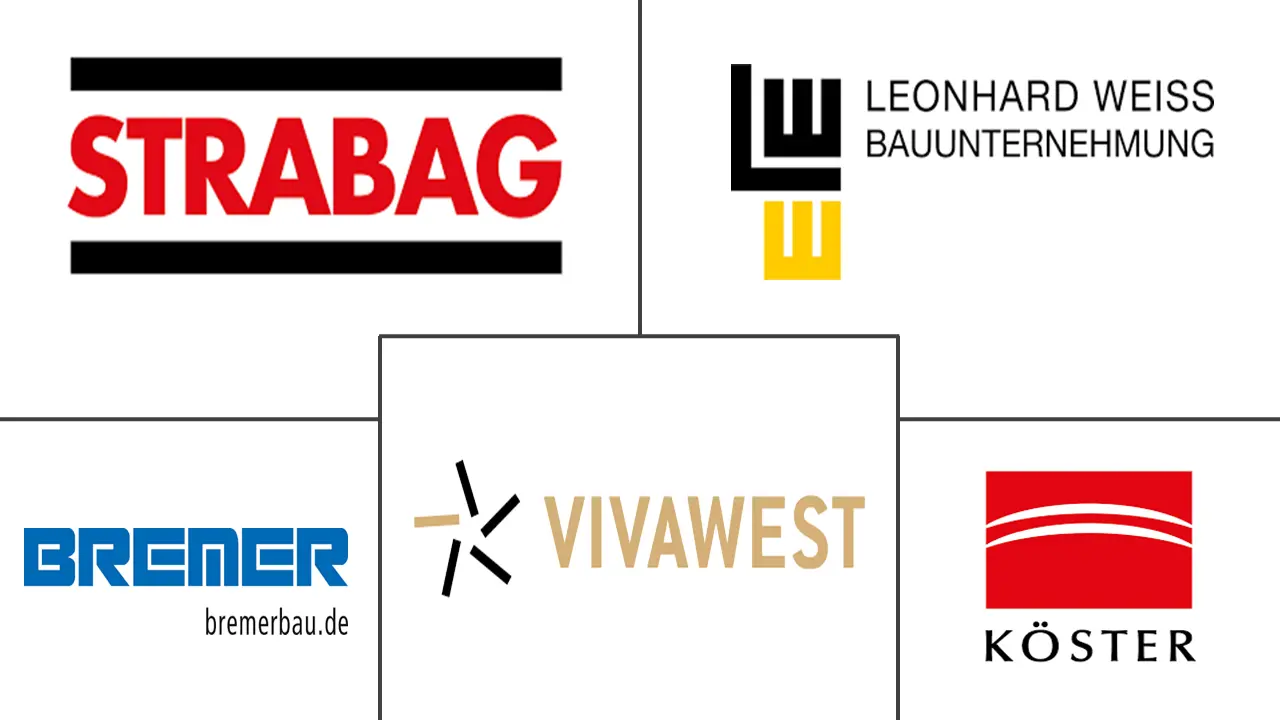Market Size of Germany Condominiums and Apartments Industry

| Study Period | 2020 - 2029 |
| Base Year For Estimation | 2023 |
| Forecast Data Period | 2024 - 2029 |
| Historical Data Period | 2020 - 2022 |
| CAGR | 7.80 % |
| Market Concentration | Medium |
Major Players
*Disclaimer: Major Players sorted in no particular order |
Germany Condominiums & Apartments Market Analysis
The Germany Condominiums and Apartments Market is anticipated to register a CAGR of more than 7.8% over the forecast period.
- The residential real estate market came to a halt due to the COVID-19 pandemic, as the government implemented lockdowns and citizens were forced to stay at home. Due to low borrowing rates, a lackluster supply of new homes being built, and increasing demand from more than 1 million refugees, Germany's long-running housing price boom is still strong despite the global epidemic. This is a huge change in a nation where the housing market has always been incredibly steady.
- In 2021, the upward trend in home and apartment prices persisted. According to bulwiengesa, the overall indexes for home and apartment prices in the 126 cities that we track increased by around 6 to 7% from 2020, which is roughly in line with the rate of the years before.
- All four groupings, specifically newly constructed and existing condominium units and terraced homes, followed the average very closely. In the same way, as in the years before, rents also continued to climb, albeit at a slower rate. Re-let and new unit rents increased by around 3% and 4%, respectively. As a result, the initial gross rental returns for both new and existing properties fell to 3.1% and 3.7%, respectively.
- In the year leading up to Q1 2021, the price of apartments increased by 11.46% (or 9.61% when adjusted for inflation), which is a minor decrease from the 13.61% growth seen in Q1 2020. Apartment prices increased by 4.02% every quarter (2.1% inflation-adjusted).
- Inflation-adjusted new home prices increased by 5.73% and 1.63%, respectively, year over year and quarter over quarter. Price increases for existing homes were 14.73% (12.83% inflation-adjusted) year over year and 4.07% (2.15 inflation-adjusted) quarter over quarter.
- The fourth quarter of 2021 saw an increase in apartment prices of 12% on average, which was the highest rate of price growth since records began in 2000. Since the pandemic started, prices have risen. It climbed by 8.25% through Q3 2021, after experiencing Y-o-Y increases of 8.38% in Q2 2021, 7.95% in Q1, 8.8% in Q4, and 7.38% in Q3 2020.
- Berlin, the capital of Germany, is the seventh-most populous city in the EU. The city's young population and expanding status as a European center for the arts and media have helped the residential sector of the economy. Numerous prestigious universities, orchestras, museums, amusement parks, and other creative businesses are located there.
Germany Condominiums & Apartments Industry Segmentation
A private residence in a building or house divided into several separate dwellings is known as an apartment. A condominium (also known as a "condo") is a large property complex made up of individual units owned separately. Typically, ownership includes a nonexclusive interest in certain "community property" managed by the condominium management. The Germany condominiums and apartments market is segmented by cities (Berlin, Hamburg, Munich, and Other Cities). The report offers market size and forecasts for the Germany condominiums and apartments market in value (USD billion) for all the above segments.
| By Country | |
| Berlin | |
| Hamburg | |
| Munich | |
| Other Cities |
Germany Condominiums and Apartments Market Size Summary
The Germany condominiums and apartments market is experiencing a robust growth trajectory, driven by a combination of factors including low borrowing rates, a limited supply of new homes, and a significant influx of refugees. Despite the challenges posed by the COVID-19 pandemic, the market has shown resilience, with housing prices continuing to rise. This trend is particularly evident in major cities like Berlin, Munich, and Frankfurt, where demand for residential real estate remains high. The market's stability is further supported by the ongoing demand for urban living spaces, which has been bolstered by the country's strong economic fundamentals and the appeal of its cultural and educational institutions.
The market landscape is characterized by a mix of local, regional, and global players, with companies such as Strabag AG, Leonhard Weiss Gmbh & Co. KG, and Vivawest GmbH playing significant roles. The demand for affordable housing and multi-family residential units is a key driver, prompting existing players to invest in these segments to maintain their market positions. Recent developments, such as NREP's strategic investments and partnerships in Germany, highlight the dynamic nature of the market. As the supply of residential properties remains constrained, particularly in desirable locations, prices are expected to hold steady, with modest increases anticipated in select areas. The market's resilience and growth potential make it an attractive proposition for investors and developers alike.
Germany Condominiums and Apartments Market Size - Table of Contents
-
1. MARKET INSIGHTS
-
1.1 Current Economic Scenario and Consumer Sentiment
-
1.2 Residential Real Estate Buying Trends - Socioeconomic and Demographic Insights
-
1.3 Government Initiatives and Regulatory Aspects Pertaining to the Residential Real Estate Sector
-
1.4 Insights into the Size of Real Estate Lending and Loan-to-value Trends
-
1.5 Insights into the Interest Rates for the General Economy and Real Estate Lending
-
1.6 Insights into the Rental Yields in the Residential Real Estate Sector
-
1.7 Insights into the Capital Market Penetration and REIT Presence in the Residential Real Estate Sector
-
1.8 Insights into the Support Provided by the Government and Public-Private Partnerships for Affordable Housing
-
1.9 Insights into the Tech and Startups Active in the Real Estate Sector (Broking, Social Media, Facility Management, and Property Management)
-
1.10 Impact of COVID-19 on the Market
-
-
2. MARKET SEGMENTATION
-
2.1 By Country
-
2.1.1 Berlin
-
2.1.2 Hamburg
-
2.1.3 Munich
-
2.1.4 Other Cities
-
-
Germany Condominiums and Apartments Market Size FAQs
What is the current Germany Condominiums and Apartments Market size?
The Germany Condominiums and Apartments Market is projected to register a CAGR of greater than 7.80% during the forecast period (2024-2029)
Who are the key players in Germany Condominiums and Apartments Market?
Strabag AG, Leonhard Weiss Gmbh & Co. KG, Köster GmbH, Vivawest GmbH and Bremer AG are the major companies operating in the Germany Condominiums and Apartments Market.

